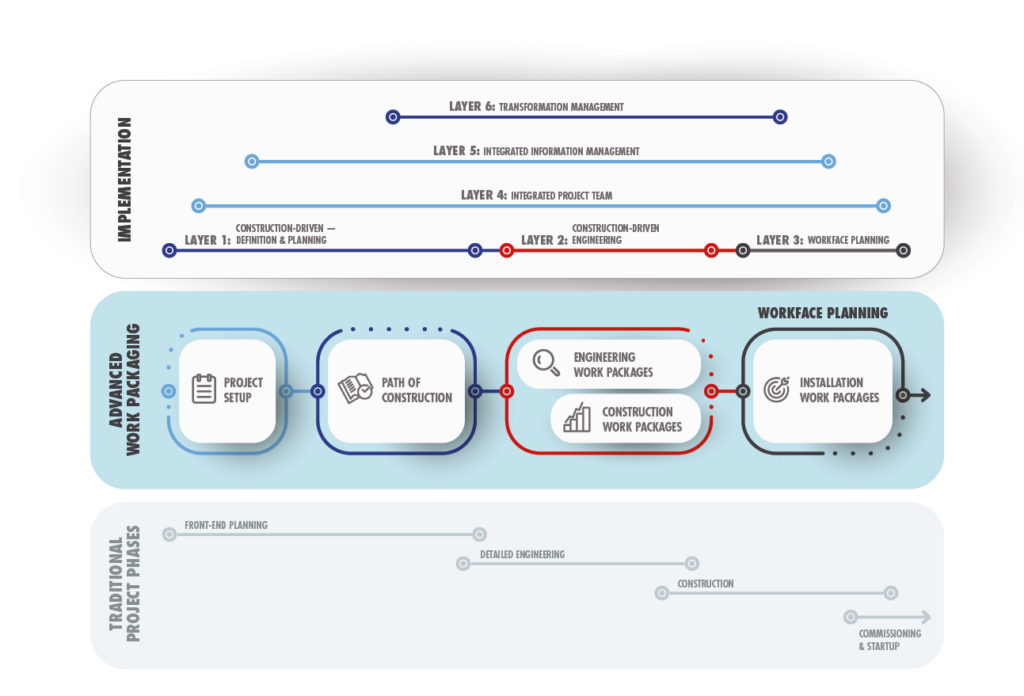Improve your field planning to maximize on-tool time and reap all the benefits of Advanced Work Packaging (AWP)
The third layer in our proprietary Advanced Work Packaging (AWP) implementation program is workface planning, a term that will be familiar to most who have studied the AWP framework. Here at Concord®, we treat workface planning as a discrete step in the AWP implementation process because it is a critical success factor that presents unique challenges and risks. In this article, we’ll walk through the most important elements of this process.
What is Workface Planning?
In construction capital projects, Workface Planning — or WFP, for short — is the creation of fully resourced packages of work that can be executed by a single construction crew in five to 10 days, or around 1,000 hours. These blocks of work, called Installation Work Packages or IWPs, are delivered to the construction team and form the foundation of efficient field execution.
Installation Work Packages have four important characteristics: they are developed by a dedicated Workface Planner, they’re broken down by trade or discipline, they are fully resourced and ready to execute, and they are subject to active constraint management.
When to Implement Workface Planning
Some companies begin their transition to AWP with Implementation Layer 3 because it can be the easiest way to get buy-in from those who will be most impacted by the transition to a construction-driven project delivery system. This can be especially true for EPC or construction management companies, because the move to master workface planning in these sectors can help secure a significant competitive advantage right out of the gate. Indeed, it is our view that WFP will eventually be standard practice, and any company that has not adopted these practices will be missing a critical and expected business function.
It is worth noting that in rare cases, the implementation of workface planning can be a stand-alone process. This is typically the case for subcontractors and construction management teams.
Garbage In, Garbage Out
The most important foundation for high-quality workface planning is the availability of construction-driven definition, planning and engineering deliverables. These, of course, are the work products of Implementation Layer 1 and Layer 2. If the first two layers of the system aren’t in place — if you don’t have a Path of Construction, Engineering Work Packages and Construction Work Packages — then your Installation Work Packages won’t deliver the results you want. Building IWPs with poor data is like building a house on sand.
On the positive side, if you have poor plan and you attempt to apply workface planning, you will quickly learn that your plan is in trouble. It is much better to uncover these problems before construction begins!
The Importance of a People-Centered Approach
The workface planning process is important, but your people are even more important. To start, your Workface Planner must have the unique ability to connect the field to the office in an effective way. This work goes well beyond authoring IWPs and helping develop the lookahead plan to facilitating clear communication and managing conflict. This is a unique skill set that requires xx training. Concord®’s Workface Planning Certification program is a great option, and has been used by major global companies like Shell to train their key people in workface planning fundamentals.
Beyond the Workface Planner, everybody on the project needs to understand Advanced Work Packaging fundamentals. It’s not enough to simply put a Workface Planner in place, you must ensure that everyone — including subcontractors and administrators — understand what the planner is doing. If you fail to do this, you’re setting up your Workface Planner for failure. We developed the two-hour online Advanced Work Packaging 101 course to help bring your team up to speed.
In our next article in this series, we’ll focus on Layer 4: The Integrated Project Team. If you haven’t already, please take a moment to read through the first three articles in this series, linked below. If you’re looking for support in your own AWP implementation process, contact us.
Read the first three parts of this series:
An Introduction to Advanced Work Packaging Implementation Layers
AWP Implementation Layer 1: Adopt Construction Driven Definition and Planning
AWP Implementation Layer 2: Embrace Construction-Diven Engineering






